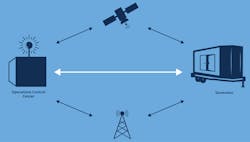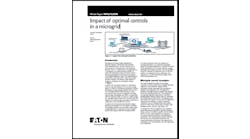3 reasons your microgrid controls should be able to communicate in real time
With the ever-evolving technological backdrop to society, people want instant feedback and access to information. We can monitor our front porch video feed from our cell phone while we are on a beach vacation, we can preheat the oven at our house before we leave the office, and we can start our cars in the bitter cold winter from the comfort and warmth of our homes. With the advancement of technology not slowing down, microgrids should have the functionality to communicate in real time. Below are three things a microgrid controller should be able to do: accept control commands, engage in site and wide area optimization and report its own health.
Accept control commands
Modern microgrid control systems have many features for managing the combined resources within their purview. A good example of a feature grouping is the algorithms involved in the control of storage batteries. Given some understanding of the future, such as tomorrow’s weather forecast or tomorrow’s power pricing, decisions must be made about when to charge and when to discharge the battery. Many other control decisions have to be made in a multiresource microgrid.
But a common situation with grid-connected microgrids is that their resources are enrolled in utility programs for demand response or grid ancillary services. This means that the utility, from a regional scope, is making decisions on when to call enrolled resources into action. The classic example is when a regional grid is experiencing a peak demand period and decides to call enrolled distributed generation resources into service. When something like this scenario arises, it is imperative that enrolled resources be contacted and activated. Mesa Solutions has the capability to receive utility instructions and, in turn, distributed generators can send command and control signals over cell or satellite communication channels.
Engage in site and wide area optimization
As microgrid adoption grows so too will the growth of multiple microgrids deployed as assets of a single enterprise. The “single enterprise” may be a company that puts microgrids at multiple geographically separated locations with the goal of operating them in some orchestrated fashion. Or it may be a utility’s region or district with multiple microgrids that are in the same general area but electrically transparent to each other. In both these examples, a control system with a higher purview than each microgrid’s individual control system must be able to not only send command and control signals to the microgrids, but it must also be able to retrieve operational data about the resources in each microgrid. For example, it may need to constantly know how much energy each is producing, how much charge remains in the batteries, etc. All this requires a robust telematics/telemetry capability to be present in the control system of each microgrid.
Report its own health
Further, a microgrid must be able to report its own health, which means reporting the health of each resource. Each resource has to be able to report its energy output. Generators have to report their engine temperature. Breakers have to report their open/close status. Additionally, maintenance personnel have a keen interest in observing changes in operation parameters. It is desirable to avoid the situation in which a simple alarm reports that a component has failed or that a limit has been exceeded. What is far more desirable is to intelligently and constantly observe operating conditions and make note of when an operating parameter may be drifting toward a limit. Once such a trend is discovered, remedial action can be taken, and unplanned outages avoided.
Microgrids need to be able to communicate in real time to achieve all these larger scope capabilities. Originating the data within the equipment is the starting point. Then the data has to be transmitted over the wide area communication infrastructure. Finally, smart systems and smart people have to leverage the value of the data to achieve reliability and resiliency.
Tom Poteet is vice president of corporate development at Mesa Solutions.








